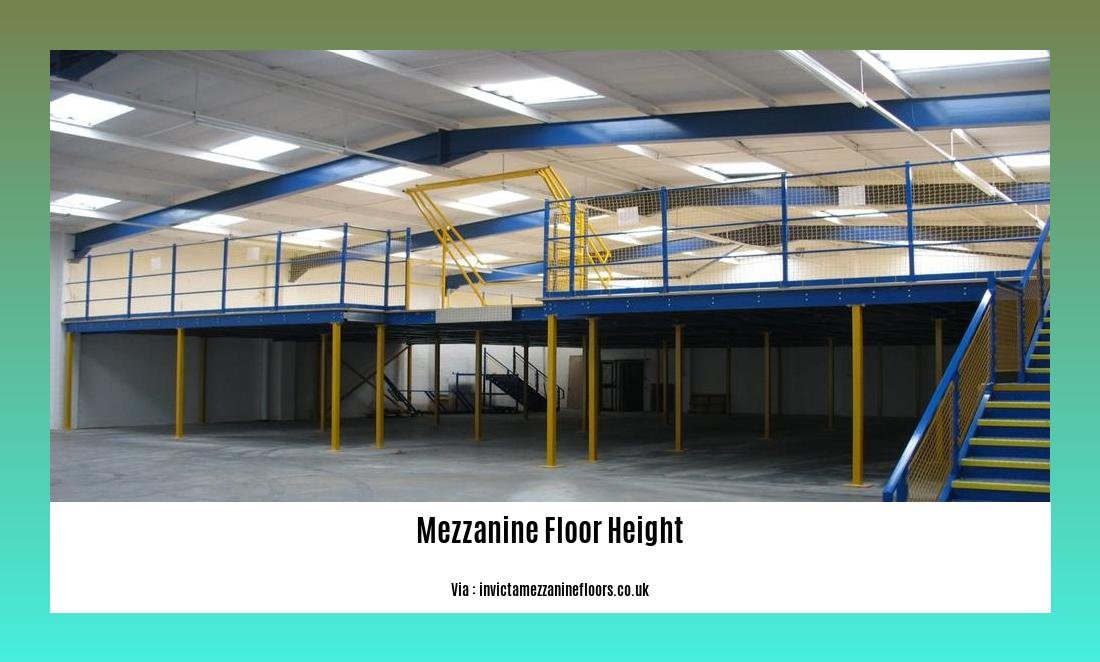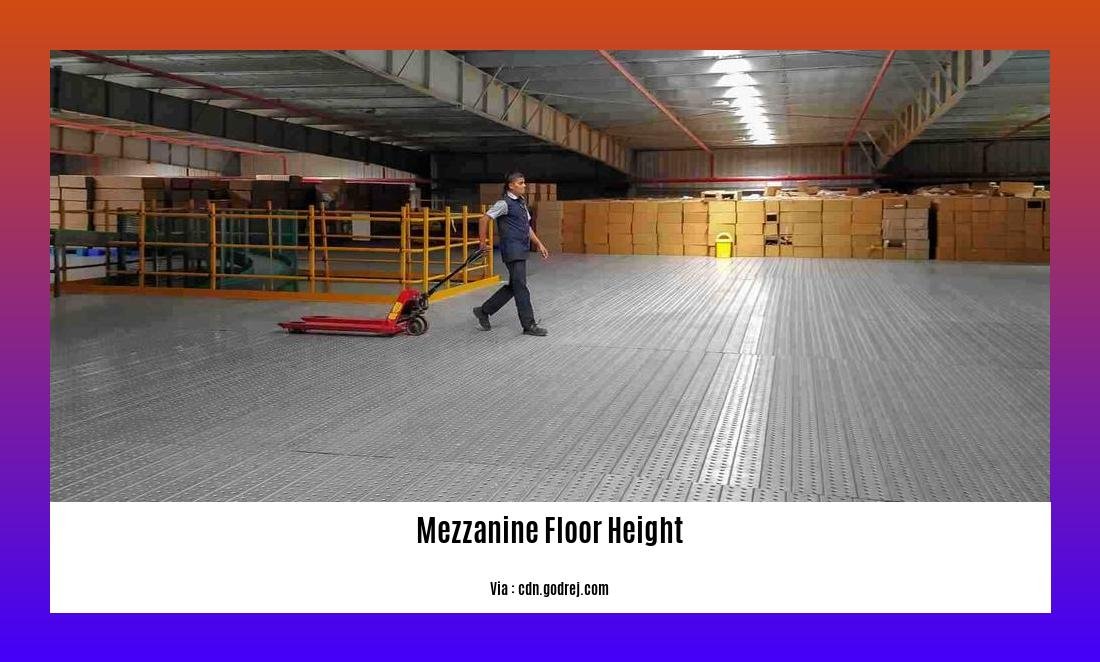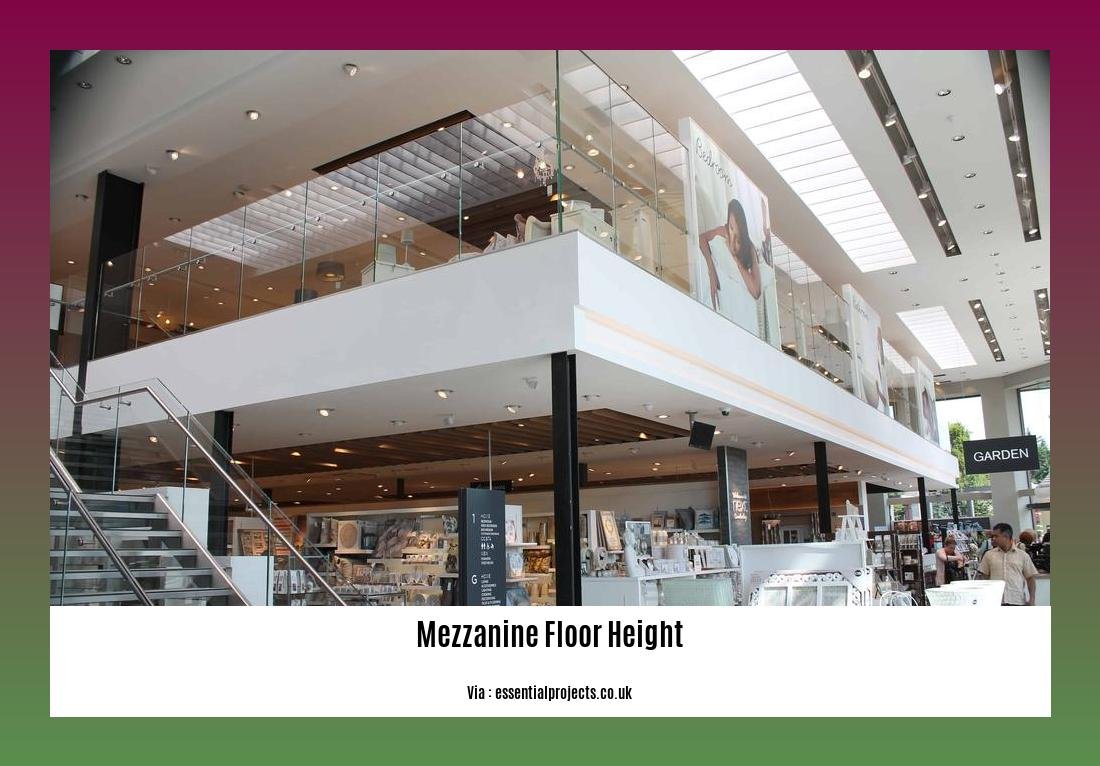When it comes to optimizing building design, one crucial factor that often goes overlooked is the height of mezzanine floors. Mezzanine floors serve a variety of purposes and can provide significant benefits for a range of commercial and industrial spaces. Understanding the importance of mezzanine floor height is key to maximizing space utilization, enhancing functionality, and ensuring compliance with safety regulations. In this article, we will delve into the significance of mezzanine floor height and how it can positively impact building design and overall usability.
Key Takeaways:
1. Mezzanine floors provide additional floor space in a building’s interiors without being counted as a full floor.
2. The minimum height above and below a mezzanine floor should be 2 meters.
3. The total height of a room planned to have a mezzanine floor is typically around 4.2 meters.
4. Mezzanine floors can be constructed using concrete, steel, or wood.
5. Mezzanine floors increase the available space and can be installed easily with minimal disruption to the business.
6. Designers and builders must consider maximum height and clearance requirements when constructing mezzanine floors.
7. The clear height above and below a mezzanine should not be less than 7 feet.
8. The total area of a mezzanine within a room should not exceed certain limitations.
9. Understanding the features, types, and code requirements of mezzanine floor construction helps designers and builders incorporate them effectively into their projects.
Mezzanine Floor Height: Maximizing Building Design and Functionality

Mezzanine floors are an excellent solution to optimize the space and functionality of a building’s interiors. They provide additional floor space without being counted as a full floor, creating opportunities for increased productivity and efficiency. However, when it comes to designing and constructing mezzanine floors, one crucial aspect that should never be overlooked is the mezzanine floor height.
The Importance of Mezzanine Floor Height
The height of a mezzanine floor plays a fundamental role in determining its usability, safety, and overall impact on the building design. Here are some key reasons why mezzanine floor height is of utmost importance:
-
Safety Regulations: Building regulations and safety codes dictate specific requirements for mezzanine floor heights to ensure the well-being of occupants. These regulations aim to prevent head injuries and provide adequate clearances for people to move comfortably beneath and above the mezzanine level. By adhering to these regulations, you demonstrate your commitment to safety and compliance.
-
Maximum Load Capacities: Understanding the desired purpose and load-bearing requirements of the mezzanine floor is essential. The height of a mezzanine floor directly impacts its weight-bearing capacity and structural stability. A higher mezzanine floor allows for a stronger foundation and potentially greater load-bearing capabilities.
-
Structural Support: Mezzanines rely on proper structural support to ensure their durability and longevity. The height of the mezzanine plays a vital role in determining the required structural elements such as columns, beams, and connections. By considering the mezzanine floor height in the design stage, you can optimize the structural support system, avoiding costly modifications later on.
-
Usability and Functionality: The height of a mezzanine greatly influences its functionality and its ability to accommodate specific activities or equipment. Whether it’s creating additional storage space or setting up an office, the height of the mezzanine floor should align with the intended use. By carefully considering the mezzanine floor height, you can create an optimal working environment that maximizes productivity and comfort.
Determining the Appropriate Mezzanine Floor Height
Now that we understand the importance of mezzanine floor height, let’s explore how to determine the appropriate height for your specific project. Consider the following factors:
-
Building Regulations: First and foremost, familiarize yourself with the local building codes and regulations that govern mezzanine floor construction. These regulations will typically provide minimum clearance requirements for both the space above and below the mezzanine floor.
-
Ceiling Height: The height of the existing ceiling or the desired ceiling height for your building plays a crucial role in determining the mezzanine floor height. By ensuring the mezzanine floor height is proportionate to the ceiling height, you can create a harmonious and well-designed space.
-
Intended Use: Think about how the mezzanine floor will be utilized. Will it be used for storage, office space, or manufacturing? Different purposes may require different heights to accommodate equipment, machinery, or people comfortably.
-
Safety Considerations: As mentioned earlier, safety should always be a top priority. Ensure that the mezzanine floor height allows for sufficient clearances above and below, preventing any potential hazards or collisions.
By carefully considering these factors and consulting with experienced professionals, such as structural engineers and architects, you can determine the most appropriate mezzanine floor height for your specific project.
Conclusion
Mezzanine floors are a valuable addition to any building, providing extra space and enhancing overall functionality. However, to fully optimize their potential, it is crucial to give due consideration to the mezzanine floor height. By adhering to safety regulations, understanding load capacities, ensuring proper structural support, and evaluating the intended use, you can design and construct mezzanine floors that effectively maximize space utilization and contribute to an efficient and well-designed building.
Remember, when it comes to mezzanine floor height, it’s not just about meeting regulations and requirements; it’s about creating a space that meets the needs of its occupants and enhances their experience within the building.
For more information, consider these sources:
- The Constructor
- Excalibur Steel Buildings
- Building Code Trainer
To know about the ideal Mezzanine floor height in houses in India, click here.
Curious about the regulations surrounding Mezzanine floor height? Find out more by clicking here.
For a detailed Mezzanine floor plan drawing, click here.
If you want to explore the requirements for obtaining planning permission for a Mezzanine floor, click here.
Uses for Mezzanine Floors

Mezzanine floors are a key structural element in building design that offers various uses and benefits. Whether you’re looking to optimize space utilization in commercial or industrial properties, mezzanine floors provide a versatile solution that can be tailored to your specific needs. In this article, we will explore the different uses for mezzanine floors and how they can enhance building functionality and design.
Maximizing Space Utilization
One of the primary uses of mezzanine floors is to maximize space utilization in buildings. By constructing an intermediate level between the ground and first floor, you effectively create additional floor space without the need for extensive renovations or expansions. Mezzanine floors are particularly popular in commercial and industrial settings where space is often limited, such as warehouses, retail stores, and offices.
With the ability to customize the size and layout of mezzanine floors, you can adapt them to suit your specific needs. Whether you require additional storage space, workspace, or a dedicated area for displaying products, mezzanine floors offer unparalleled flexibility in optimizing the use of your building’s interior.
Enhanced Workflow and Functionality
Another important use for mezzanine floors is to enhance workflow and functionality within a building. By incorporating a mezzanine level, you can create separate zones or departments that streamline operations and improve efficiency. For example, in a warehouse setting, you can designate the ground floor for receiving and packaging, while the mezzanine level can be used for sorting and organizing inventory.
Mezzanine floors also offer the opportunity to create dedicated office spaces, meeting rooms, or break areas within a larger building. This not only improves functionality but also contributes to employee satisfaction and productivity, as it provides designated spaces for different activities.
Retail and Display Areas
Mezzanine floors are commonly utilized in retail settings to create additional display and retail areas. By adding a mezzanine level, retailers can expand their floor space without the need for costly renovations or relocation. Mezzanine floors offer an elevated platform for showcasing products, attracting customers’ attention, and creating unique shopping experiences.
With the ability to customize the design and layout of mezzanine floors, retailers can create visually appealing and functional display areas that effectively showcase their merchandise. From clothing boutiques to home decor stores, mezzanine floors provide endless possibilities for creating eye-catching retail spaces.
Key Takeaways:
- Mezzanine floors are a versatile solution for maximizing space utilization in buildings.
- They can be customized to suit specific needs, whether it’s for storage, workspace, or retail areas.
- Mezzanine floors enhance workflow and functionality within a building, optimizing operational efficiency.
- They offer opportunities to create dedicated office spaces, meeting rooms, and break areas.
- Retailers can utilize mezzanine floors to expand their floor space and create attractive display areas.
Citation: [The Constructor – Mezzanine Floor for Buildings: Important Features and Types]
The Benefits of Having a Mezzanine Floor
When it comes to optimizing building design, one element that plays a crucial role is the height of the mezzanine floor. Mezzanine floors are intermediate levels constructed between the main floor and ceiling of a building, offering additional floor space without being counted as a full floor. In this article, we will explore the benefits of having a mezzanine floor and how its height can impact building design and functionality.
Maximizing Space Utilization
One of the key benefits of installing a mezzanine floor is the ability to maximize space utilization in a building without the need for extensive renovations or expansions. With a mezzanine floor, you can effectively increase the available floor area, allowing for various applications such as storage, workspace, or retail areas. By making efficient use of vertical space, you can create dedicated zones or departments, enhancing workflow and functionality within the building.
Flexibility and Customization
Mezzanine floors offer immense flexibility and can be customized to meet specific requirements. Whether you need additional office spaces, meeting rooms, break areas, or retail display areas, a mezzanine floor can be tailored to suit your needs. This customization allows for adaptability in the ever-changing demands of a business, ensuring that the building’s design remains versatile and capable of accommodating future growth.
Cost-Effective Solution
Compared to traditional building extensions or renovations, mezzanine floors provide a cost-effective solution for expanding floor space. The construction of a mezzanine floor is relatively quick and efficient, causing minimal disruption to ongoing operations. This cost-effectiveness makes mezzanine floors a popular choice in commercial and industrial settings with limited space, allowing businesses to optimize their operations without a significant financial investment.
Quick Return on Investment
Investing in a mezzanine floor can result in a quick return on investment. By effectively utilizing the available space and increasing operational efficiency, businesses can experience improved productivity and profitability. Mezzanine floors can create an environment that facilitates organized workflows and enhances employee productivity. Additionally, if the building is used for retail purposes, mezzanine floors can expand the floor space, allowing for attractive displays that attract more customers and potentially increase sales.
Enhanced Building Functionality
Mezzanine floors significantly enhance the functionality of a building. By utilizing vertical space, you can create separate levels for different purposes, optimizing the overall workflow and operations. Mezzanine floors can be used to accommodate various functions such as office spaces, conference rooms, storage areas, employee break rooms, or even dining spaces in restaurants. This versatility and added functionality make mezzanine floors a valuable addition to any building.
Key Takeaways:
– Mezzanine floors maximize space utilization in buildings without extensive renovations or expansions.
– They are popular in commercial and industrial settings with limited space.
– Mezzanine floors can be customized for storage, workspace, or retail areas.
– They enhance workflow and functionality by creating separate zones or departments.
– Mezzanine floors can be used to create dedicated office spaces, meeting rooms, and break areas.
– Retailers can use mezzanine floors to expand their floor space and create attractive display areas.
Citation:
– ResinDek: What is a Mezzanine Floor
– Homenish: Mezzanine Floor – What It Is, Benefits, Cost
FAQ
Q1: What Is the Mezzanine Level For?
A1: The mezzanine level is an intermediate floor constructed within a building, typically between the ground and first floor levels. It provides additional floor space without being counted as a full floor, allowing for increased storage, workspace, or retail area.
Q2: What Is a Mezzanine?
A2: A mezzanine is a space located between the main floor and ceiling of a building, which is smaller than the overall footprint of the building. It is designed to optimize space utilization by creating an intermediate level for various purposes such as offices, bulk storage, or employee cafeterias.
Q3: What are the Uses for Mezzanine Floors?
A3: Mezzanine floors have a wide range of uses and can be tailored to specific needs. They can be used to create additional office space, storage space, production areas, or retail showrooms. The flexibility of mezzanine floors allows businesses to adapt their space to changing needs and maximize their building’s potential.
Q4: What are the Benefits of Having a Mezzanine Floor?
A4: Having a mezzanine floor offers several benefits, including:
– Increased interior space: Mezzanine floors provide additional floor area, allowing businesses to expand their operations without the need for costly building expansions.
– Easy installation: Mezzanine floors can be installed relatively quickly and easily, causing minimal disruption to daily operations.
– Versatility: Mezzanine floors can be customized to suit specific requirements, allowing businesses to optimize their space for various purposes.
– Cost-effective solution: Compared to constructing an entirely new building or renting additional space, installing a mezzanine floor is a cost-effective way to maximize the use of existing premises.
Q5: How does Mezzanine Floor Height Impact Building Design?
A5: Mezzanine floor height is an important consideration in building design as it impacts the usability, safety, and functionality of the space. The clear height above and below the mezzanine should meet certain requirements to ensure adequate headroom for foot or robotic traffic and to comply with building codes and regulations. Proper mezzanine floor height allows for efficient utilization of space and ensures that the structure can safely support the additional load imposed by the floor.
- White Kitchen With Butcher Block Countertops: A Warm, Inviting Design - January 4, 2026
- Marble Countertops Prices: What Impacts the Overall Cost to Install? - January 3, 2026
- Marble Countertops Cost: What Factors Impact the Total Price? - January 2, 2026










